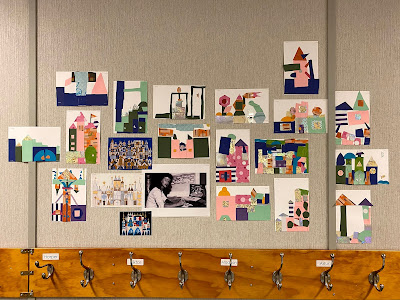Hi Families,
This week, we concluded our exploration of 2D shapes and 3D objects by participating in a community walk to look at basic and composite shapes in homes, as well as examining the art of Mary Blair in order to create our own:
Mary Blair was a Disney a concept artist.
Her art not only connected to our study of shapes, but also to perseverance.
Her art not only connected to our study of shapes, but also to perseverance.
 |
| Our art based on Mary Blair's concept art for It's a Small World. |
 |
| Using single shape materials to construct a scene, based on the book "The Shape of Things". Ask your child about theirs. |
We also continued developing our automaticity of basic facts, by exploring visual tools for helping us with our doubles facts. Each fact has a picture clue associated with it to help us remember the sum. Ask you child if they can recall the picture clues for each fact.
We also learned a new game to help practice our doubles facts called Doubles in a Row. You can find this game in Google Classroom --> Math --> Math Games --> Doubles in a Row.
Subtraction with doubles is easy, no matter the number. We know that when you have a number, and you take it ALL away, it always equals zero.
We also did a mini art/science study based on one of our schoolyard residents:
 |
| One of our resident Snowshoe Hares that consistently rests under the trees by the parking lot. March 17 - note the changing fur. |
 |
| Our Spring Snowshoe Hare art: Step by step drawing, finished with washable marker watercolour! |
 |
| Same tree, hopefully same Snowshoe Hare. March 24. |
A beautiful picture book making connections between
seasonal changes, adaptations and predators.
seasonal changes, adaptations and predators.
Many students expressed interest in trying to dye eggs at home using plants. This is the website we used as a jumping off point to create our dyes, however there are many, many other websites out there that can offer advice: https://www.goodhousekeeping.com/holidays/easter-ideas/how-to/a31737/natural-easter-egg-dyes/
 |
| From top left: black bean, avocado, blueberry, tumeric, beets, lemon, cabbage, tea. |
Cabbage is a fun one to try, as it will change colour if you use different mordants (vinegar vs. baking soda).
Have a wonderful Spring Break everyone! I look forward to seeing students back on TUESDAY, April 6th. Please see the additional blog note on our Easter Egg Hunt scheduled for that day.
Ms. Thomas



